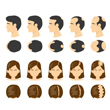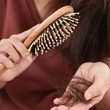Can Trichotillomania Cause Permanent Hair Loss?

Fact: Hair loss is one experience that no one wants to have. It could be caused by a variety of reasons such as nutritional deficiency, stress, age, hereditary issues, cancer treatment, and so on. (1)
In today's article, we're going to talk about trichotillomania as a whole and discuss whether or not it could result in permanent hair loss.
Keep reading to find out more...
What is Trichotillomania? 2

Trichotillomania is a mental health condition defined by an individual's extreme urge to pull out their hair. Due to its easy accessibility, the scalp is most often affected by this illness. Having said that, people who experience this issue could also rip out their eyelashes, eyebrows, and beard strands. Once pulled out, many patients eat their strands, which generally leads to several stomach issues.
The main cause for this condition is unknown. However, the symptoms of the same do cause emotional distress and can even hinder the patient's occupational and social functioning.
Can Trichotillomania Cause Hair Loss?

While frequent hair pulling can result in extensive hair loss over time, the consequences aren't permanent and can be reversed with the proper treatment.
Signs and Symptoms of Trichotillomania 2

As mentioned above, the main symptom of trichotillomania is the act of repeatedly pulling out one's own hair. Other signs of the same include the following:
- The individual experiences extreme stress followed by a sense of great relief after pulling their hair out.
- Depending on the severity of the situation and the frequency with which they pull their strands out, the person could eventually find bald patches on their scalp.
- As a result of their condition, the patient may encounter a generalized tingling or itching sensation (also known as pruritus) in the affected area.
- The individual may encounter an undeniable urge to twist their hair. In certain cases, this urge could also lead to stress, which, in turn, could lead to the person pulling out their strands to experience relief.
- Apart from the above, the patient may also exhibit a variety of ritualistic behaviors such as counting their strands, trying to place each strand in order, and playing with their hair roots (also known as bulb roots). In rare cases, this may occur before the hair-pulling phase, and loved ones are generally asked to look for these early signs to treat the condition in time.
- The patient may try to conceal their hair pulling tendencies. In many cases, this act could appear in the form of adding extensions to the hair or wearing caps, false eyelashes, and wings in public settings. They may also be extremely secretive about their behavior and can avoid socializing to avoid spotlighting their lack of hair.
- Once pulled out, the person may either hide or ingest their hair. Repetitive ingestion of hair could result in the formation of a hairball in the stomach. This could cause nausea, abdominal pain, anemia, and issues related to bowel movements.
- Besides hair-related symptoms, individuals may also showcase other signs of this condition. These include the following:
- The abrading or excoriation (wearing off) of skin
- Cracking one's knuckles
- Extreme scratching of one's skin
- The gnawing of one's skin
- Biting one's nails
What are the Treatment Options Available for Trichotillomania? 2

As mentioned before, hair loss due to trichotillomania isn't permanent, and the condition can be reversed provided the patient undergoes the proper treatment.
Treatment is further split into two variations:
a) Psychotherapy
Simply put, psychotherapy uses various psychological methods to cure one's trichotillomania. This includes cognitive-behavioral therapies like awareness training, habit reversal, and stimulus control. This kind of treatment aims to understand and change the individual's emotions to prevent their hair-pulling behavior.
b) Pharmacotherapy
This type of therapy uses medication to treat mental conditions. Having said that, the majority of medications available today are still pending clinical trials and are, therefore, not considered to be extremely safe.
Currently, more research is required to determine whether these therapies work better in tandem or apart.
If you experience hair loss due to trichotillomania, we highly recommend visiting the dermatologist as soon as possible. In most cases, the doctor will conduct some tests on your scalp and ask you a few questions about your condition and the kind of medication you're taking to combat the symptoms of the same. Based on your answers and the severity of your condition, the doctor could prescribe an array of treatment options to combat your hair loss.
To Wrap up
Needless to say, trichotillomania is a serious mental health condition that could result in extreme stress and low self-esteem issues. However, with the proper treatment, the individual will be able to grow their hair back in no time.
Myth Busters HairFall

Androgenetic Alopecia - Everything You Need To Know
Have you been experiencing excessive hair fall over a prolonged period of time? It could be an early sign of androgenetic alopecia. It is a hair loss disorder common in both genders and can lead to progressive thinning and even baldness in some patients if not caught and treated early.

How To Make Hair Grow Faster For Men
A head full of healthy hair is a matter of confidence. Hair has its own mechanism of growing and shedding, and it is when this mechanism is thrown off that growth is hindered. Especially in the case of males, hair growth faces a lot of hiccups that can easily be managed.

Female Pattern Baldness - Causes & Treatments
Have you suddenly noticed an increase in the number of hair strands on your pillow in the morning? Or is your ponytail getting thinner by day? Well, you might be suffering from female pattern baldness. While that does sound scary, identifying it early on is key to treating this condition effectively. So keep reading to know what this is, how you can identify it, and most importantly, what treatments you can avail of to get your beautiful lustrous hair back.

What Are The Reasons For Hairfall?
Almost everyone experiences some amount of hair thinning over the years. Shedding around 50 to 100 single strands of hair per day is considered normal. However, losing more than 150 strands a day, experiencing sudden thinning, or developing circular bald patches on your scalp are reasons for concern. Hair loss occurs when new hair doesn’t grow fast enough to replace the amount of hair you lose daily. Hair can fall due to various reasons, with hereditary hair loss and poor nutrition being the most common hair fall reasons.

Expert Approved Tips For Hair Growth
What can be more debilitating than seeing hundreds of hair strands shedding from your scalp every time you brush your hair? Also, excessive molting occurs during seasonal changes that can be very stressful for you. Although it’s okay to lose between 50-100 strands every day, according to the American Academy of Dermatology, the problem occurs when you start shedding more than normal. But that doesn’t mean you have to feel helpless as there are ways to grow your hair back. Even if you are coping with baldness or alopecia, certain hair growth tips from dermatologists can come to your rescue. Read on to discover how these tips can be your savior when abnormal hair fall problems are in sight.
Trending Videos
+ 2 Sources
'LMRC - GGI-CO-A2-DMA-300001252-300001252-WM-L21-704'
© 2021 Dr. Reddy’s Laboratories Ltd. All rights reserved.